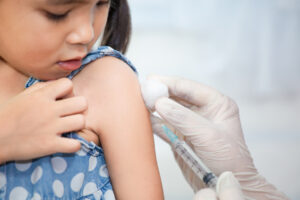
Without a doubt, vaccines are the most important contributing factor to the health of our children. The World Health Organization estimates that worldwide, there are 2-3 million fewer deaths each year due to vaccination programs, yet 1.5 million people still die from vaccine preventable disease each year. So why are we seeing a decrease in vaccine coverage in recent years? Certainly, social media, and perhaps the general media, has been a source for conflicting or unsubstantiated reports. Many false claims about vaccines can be easily debunked. Common myths include concerns about overwhelming the immune system or harmful ingredients like Mercury, Formaldehyde, and Aluminum. It’s crucial to rely on accurate information and speak to your Physician to make informed decisions about vaccinations.
How Vaccines Work
The human immune system is a remarkable and highly effective bodily mechanism. Like learning to read, the immune system reads the information (the Antigen) from a virus or bacteria and remembers it for later by producing Antibodies. It is estimated that we are capable of producing 10 billion different antibodies but on average make between 1 million to 100 million different ones over our lifetime. All of the current vaccines required by age 2 prevent 15 diseases and amount to a little over 300 Antigens. When your 6-month-old gets the required vaccines, totaling 67 Antigens (DTaP, HIB, Prevnar, Polio, Hepatitis B and Influenza) she is exposed to 0.3-0.5% of her average daily exposure of 2000-6000 Antigens; clearly not overwhelming her immune system. In fact, getting any of these diseases would expose your child to far more antigens requiring a far greater “immune response.”
Regarding toxins in vaccines, Thimerosal, a preservative now only found in multi-dose Influenza vaccines, is Ethylmercury. This form of mercury is different from Methylmercury, the mercury that is found naturally in the environment. Breastmilk actually has 15 times the amount of Methylmercury than the Influenza vaccine has of Ethylmercury. Aluminum is used as an “adjuvant” which increases the immune response (effectiveness) of a vaccine. The main source of Aluminum in our bodies is through food and water. In fact, the total dose of Aluminum in all of the vaccines through the first 6 months of life is 4mg. Compare this to 10 mg from breastfeeding, 40mg from cow-based formula and up to 120mg from soy formula. Studies have shown that the aluminum from a vaccine is cleared within 24 hours. Lastly is Formaldehyde, a compound used to inactivate viruses (such as Polio) and detoxify bacterial toxins (like Diphtheria). This occurs as a pollutant in the environment, but is also produced as a byproduct of metabolism in our bodies. The byproduct of Formaldehyde in cell metabolism is then used for metabolic pathways needed for important life processes. The amount of formaldehyde in our blood is 10 times the amount in any given vaccine.
The Current Vaccine Schedule
At birth, Hepatitis B vaccine (to prevent the number one cause of liver cancer worldwide), is given in the hospital (or by 2 months in your Doctor’s office) then 2 months later and 6 months after the first dose. Discuss with your Pediatrician using combination vaccines (Vaxelis, Pentacel, Pediarix, etc.), that minimize the number of injections received at the various routine visits. DTaP (Diphtheria, Tetanus, acellular Pertussis), HIB, IPV (Polio) and the Pneumococcal vaccine are given at the 2, 4, and 6-month visits with a booster at 12-15 months. The final booster dose for DTaP and IPV are given at school entry; 4-6 years of age.
Pertussis is still an important vaccine preventable disease. It is so important that all adults, especially pregnant women are recommended to get a dose to limit the spread in the community and in the case of during pregnancy, to prevent this life-threatening disease in the newborn too young to be vaccinated. Prior to the introduction of the whole cell vaccine in the 1940’s, there were 150,000-250,000 cases per year. This decreased dramatically for a few decades, but has been on the rise since the 1980’s, partially due to the introduction of the Acellular vaccine. While this vaccine is less reactogenic it is also less immunogenic. For this reason, it is important to get a booster dose every 10 years after the dose given on entering middle school.
Both the Influenza and COVID vaccines should be started at 6 months and continued annually. From 2021-2022, the CDC estimates that influenza was associated with 9 million illnesses, 4 million medical visits, 10,000 hospitalizations, and 5,000 deaths. During seasons when flu vaccine viruses are similar to circulating flu viruses, the flu vaccine has been shown to reduce the risk of having to go to the doctor by 40% to 60%.
COVID has claimed over 1.1 million adult lives in the US. The mRNA technology is not new and has been available in other therapies. Consider comparing mRNA to instructions in an email as to how to do something. Consider comparing mRNA to instructions in an email as to how to do something. You open the email, read the instructions, understand what to do and delete the email. This is what happens in the cell. The mRNA brings in the instructions on how to make the Spike protein. The cell reads the info, deletes the mRNA (the email) and makes the Spike protein that then creates an antibody response. SarsCoV2 is not going anywhere and its next variant could be a deadly one and so everyone should be vaccinated to reduce the burden of disease in the community. Nearly 1,200 children were admitted to the hospital with COVID during the week ending September 9, accounting for 6% of all admission. Half of those children admitted were under 5 yrs, not coincidently, the group with the lowest vaccination rate. The updated vaccine can help children’s immune systems learn to detect and resist the virus, including the strain that is circulating now.
For children who receive the Pfizer-BioNTech COVID19 vaccine: 6 months—4 years need 3 doses, including at least 1 updated (currently the Bivalent vaccine) dose; over 5 years need at least 1 Updated dose. For Children who receive the Moderna COVID-19 vaccine: 6 months-5 years need 2 doses, one of which must be the Updated vaccine. Those children over 6 years just need 1 Updated vaccine (Pfizer-BioNTech or Moderna). Currently, only the Bivalent dose is available but the newest “updated” vaccine (a Monovalent vaccine) is awaiting release and the recommendations presumably will be the same.
Rounding out the rest of the childhood immunization schedule includes the MMR (Measles-Mumps-Rubella) and Varivax (Chickenpox) vaccines that are given at 12 months with a booster dose at 4 years. The importance of the measles vaccine was previously discussed but these other diseases can cause lifelong problems like infertility in men (Mumps), deafness (Rubella) and Shingles. Also given during this time frame is the Hepatitis A vaccine at 12-18 months (and a booster dose 6 months later) to prevent this milder liver infection but one that can lead to liver failure (one of the most common causes worldwide). Starting at 9-12 years old, adolescents are recommended to receive the two-dose Gardasil vaccine, crucial for preventing cervical and oral cancers. At 11 years, they should get the Tdap booster (Adacel) and MenQuadfi to guard against multiple strains of Meningitis. Then, at 16 years, it’s time for the MenQuadfi booster and either Trumemba or Bexsera for additional protection against Neisseria Meningitides Group B. Remember, Trumenba #2 is given after 6 months, while Bexsera #2 is administered after just 1 month.
The newest immunization Beyfortus, a monoclonal antibody, provides direct protection via antibodies made against RSV. RSV is the number one cause for hospitalizations under 1 year of age, and the leading cause of all respiratory illnesses in children less than 5 yrs. Right now the AAP is vigorously working to make this available through insurance to all eligible babies. This would include infants younger than 8 months, born during – or entering – their first RSV season, which typically takes place fall through spring.
Vaccines save lives and there are no drugs on the markets more rigorously tested. Those that review the data are lifelong academicians who have dedicated their lives to securing the health and wellbeing of our children. I have heard many of them speak and their passion and belief in protecting the public health of all is admirable. It is important to speak to your Physician to be able to make an informed decision for both you and your children.

Dr. Robin Straus-Furlong is a proud member of the TopLine MD Alliance practicing Pediatric Care at Beachside Pediatrics in Miami-Dade County.
The TopLine MD Alliance is an association of independent physicians and medical practice groups who are committed to providing a higher standard of healthcare services. The members of the TopLine MD Alliance have no legal or financial relationship with one another. The TopLine MD Alliance brand has no formal corporate, financial or legal ties to any of the affiliated physicians or practice groups.



